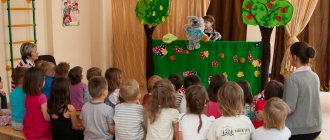Conversations about kindness
Moral conversations with a child are very important. They not only contribute to the development of children’s horizons and ability to reason, but also cultivate the ability to see and give kindness to others, and cultivate politeness, attention and care in children.
What is kindness
Kindness is responsiveness, emotional disposition towards people, the desire to do good to others. It is associated with other positive qualities: humanity and philanthropy, nobility and generosity, politeness and good manners, care and sympathy, goodwill and attentiveness, sensitivity and patience.
Let's figure out what these character traits mean.
Humane is someone who has a good heart inside, who loves other people and acts like a real person.
When a person loves people, tries to see the good in others, helps people, then this quality is called philanthropy.
Nobility is the ability to behave beautifully and honestly in any situation.
A generous person has greatness of soul, knows how to forgive, and even behaves beautifully and honestly with bad people. Such a person does not harm animals and treats nature with care.
Sensitivity is when a person well understands and feels the mood and desires of another person, and is able to feel sorry for him.
Responsiveness is when a person responds to other people’s requests and tries to help.
Politeness is a person's friendly, respectful behavior and communication with other people.
Kindness is the ability to treat people, animals, nature well, to wish the best for loved ones and strangers.
Treat others the way you want to be treated
People are born with varying degrees of kindness. But you can increase the amount of kindness in yourself, you need to strive to be kind. Why be kind? Every person likes it when others love him, forgive him, help him, treat him well, when he has many friends. But this is only possible if a person himself behaves this way with others. An indifferent, angry, rude person has a callous soul; it is unpleasant and uninteresting to be friends with him. And only by giving good things can we hope for a wonderful attitude from the people around us.
Kindness is so important to people that there is a special holiday - World Kindness Day. It is celebrated annually on November 13th.
It is quite difficult for children to perceive abstract concepts. When explaining what kindness is, give specific negative and positive examples from literature and life, read philosophical fairy tales and discuss them, and, of course, inspire children with your example.
WE RECOMMEND READING:
| “Philosophy for children in fairy tales and stories” M. A. Andrianov This book invites young readers and their adult mentors to rediscover the science of humanity. It systematically and gradually introduces universal human values, the main principles in the field of ethics and aesthetics, and forms the spiritual basis for wise and highly moral behavior in the future. The book will teach a child not only to think about different aspects of life and the properties of human character, but will also significantly clarify his perception and assessment of everything around him. It will promote deep penetration into oneself and into the complex world of interpersonal relationships. | |
| “Philosophy for children in stories and pictures” Petr Ekberg Petr Ekberg's engaging storytelling and Sven Nordqvist's beautiful, beautiful illustrations will make children think about universal and important moral values, rather than just reading a book. The pictures in the book “Philosophy for Children in Stories and Pictures” are complementary in nature and represent small scenes from life that illustrate certain points discussed in the book. The publication is adapted for Russia: for example, Russian cities and the Shukhov Tower are used as examples. | |
| “Philosophy in fairy tales. Educational manual" by L. Surzhenko How to answer difficult questions for your child? The easiest way to do this is by telling a fairy tale. Before each fairy tale, the author addresses the child, freeing parents from imposing the topic; reading turns into a game of questions and answers. But this is the favorite pastime of all children! At the end of each fairy tale, you can just talk, asking each other questions. This will free parents from boring moralizing and make communication interesting, joyful and productive. Among other things, reading fairy tales together is a wonderful leisure activity. |
What is kindness?
Summary of a game GCD dedicated to the concept of “kindness” for children of the middle group.
Goal:
teaching children to correctly express their emotional state and understand the feelings of other people, developing the ability to manage their feelings and emotions.
Tasks:
- expand the idea of kindness;
- develop in children communication skills, memory, thinking, emotional responsiveness, the ability to empathize, the desire to come to each other’s aid in a difficult situation, and develop social feelings;
- expand and deepen children’s ideas about a friendly attitude towards people around them;
- reveal the importance of moral support for comrades, which can be expressed in sympathy;
- to form a child’s value attitude towards himself and others;
- teach children to correctly express their emotional state and understand the feelings of other people.
Preliminary work:
conversation on the topic of kindness, looking at illustrations of a good and bad deed.
Equipment and materials:
G. Oster's book "Bad Advice", a "magic" chair, a selection of musical works, an easel, a sun, a Dobryasha doll, flower leaves, hearts, balls.
Progress of the lesson
Educator:
My dear children, today I suggest you go to the land of Kindness, where only kind and attentive residents live.
These residents are very hospitable and they love to play with children. But only kind and well-mannered children are allowed into their country. Please remind me how to behave when visiting. ( Children's answers
.)
Educator:
Well done.
So, let's go visit. ( Children walk onto the carpet to the music. A fairy-tale character appears - Dobryasha
.)
Dobryasha
: Good afternoon, dear guests, I’m glad to see you.
What do well-mannered people do when they meet? ( They say hello
.) Let's do the same: let's say hello to our sun, to our flowers.
( Warm-up. Children reach up to the sun, bend down to the flowers that lie on the carpet
.) Oh, what is it?
We're in trouble. A strong wind came and tore off all the petals from the magical flowers. Children, I really need your help. Can you help? ( Yes
.)
Dobryasha
: Petals, guys, are not simple, but magical.
You must first say a kind word, and then put the petal in the basket. ( Children collect petals and take turns saying polite words: thank you, please, goodbye and others
.)
Dobryasha
: Thank you!
Children, I would like to tell you that you need to start every new day in a good mood. And so that the mood is good and cheerful, let's stand in a circle, hold hands, close our eyes and pass on to each other those sparkles of warmth and love that live in our hearts. Let’s call our circle “Circle of Friends.” ( Children stand in a circle and imitate movements in accordance with the text
.)
Dobryasha
: You are my friend and I am your friend. Get into the circle quickly! Hold hands tightly and smile at each other! Clap, stomp, spin And hug each other!
Have you felt how kindness passes through our hands, from palm to palm? ( Children's answers
.)
Dobryasha
: And now I suggest you sit on the chairs.
Today I would like to talk to you about kindness. About this amazing and magical word! Guys, how do you understand what kindness is? ( Children's answers
.) Do you like listening to fairy tales?
( Yes
.) Are fairy-tale heroes always only good?
( Children's answers
.)
Dobryasha
: Now I would like to see how well you know good and evil fairy-tale characters?
( The game “What fairy-tale hero is this?” Images of heroes hang on the easel, children take turns naming the heroes and saying whether the character is good or evil
.)
Dobryasha
: You did a very good job on this task.
And you know that good is a multi-valued word. The word “good” refers to treasures: books, paintings, toys, jewelry. Such goodness can be seen and even touched with your hands. Good music, heartfelt poems, and gentle words are also called good. But often the word “good” denotes actions that every person should do: you, and I, and your parents. What kind of good do you think this is? ( Children's answers
.)
Dobryasha
: Every person should be able to speak kind words, help everyone, feel sorry for and save those who are in trouble.
And, of course, the most important thing is to love. Do you know how to say kind words? ( Yes
.)
Dobryasha
: Now I’ll check it, we’ll play the game “Magic Chair”.
( All the children stand in a circle. A chair is placed inside the circle, at the edge. The children walk in a circle and sing: “Who is the most beautiful of all today? Who is the happiest of all today? Come quickly! Sit on the magic chair.” After the song ends, the one who is closest to the chair sits on it. And everyone else takes turns saying good and kind words to him
.)
Dobryasha
: Indeed, you know how to be kind.
Do you think it’s easy to be kind? ( Children's answers
.)
Dobryasha
: Yes, you are right, it is very difficult to be kind, sometimes you don’t even want to share a toy with a friend, sometimes they will offend you - and you don’t want to forgive.
But I’ll tell you one little secret: if you learn to be kind, you will always have many, many friends. Do you agree with me? ( Yes
.)
Dobryasha
: And now I would like to see what kind of friends you are. I will ask you questions, if it is said correctly, clap your hands and say “yes-yes-yes”, if incorrectly, stomp your feet and say “no-no-no”. Will we be strong friends? Should we value our friendship? Will we learn to play? Shall we help a friend? Need to piss off a friend? How about giving a smile? Should you offend a friend? Shall we drink tea with friends? Will we be strong friends?
Dobryasha
: Now I see what good friends you are!
But are you polite to each other? Now we will check this. I have a big heart and many small ones. Small hearts broke away from the big one. Help me please. ( Children answer the question and glue a small heart onto a large one. Examples of questions: What words do they say when meeting? What do you say if you accidentally push someone? Who should give up your seat in transport? How do you ask a friend for a toy?
)
Dobryasha
: Well done, you did a great job.
I see how kind and sympathetic children you are. Stay like this always. ( A surprise moment - each child receives a balloon with a smiling emoticon from Dobryasha
.)
Olga Kharitonova, teacher at GAPOU IOC named after. V. Talalikhina, P-1



